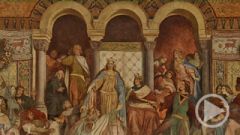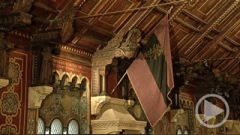Fighting the Devil: Luther and the Wartburg
Fighting the Devil: Luther and the Wartburg
On the evening of May 4, 1521, a monk was travelling near Altenstein Castle, 25 kilometres south of the Wartburg, tired and lost in thought. Martin Luther lived dangerously. At the beginning of that year, Pope Leo had excommunicated the theology professor. Now he was returning from the Diet of Worms, where he was pressed to recant his criticism of the church. But he stood firm and refused, thus souring his relationship with the emperor as well. The edict of worms formally declared him an outlaw and he was subject to being seized at any time. And, indeed, armed horsemen suddenly appeared from the forest and fell upon Luther. However, he remained surprisingly calm, because he knew the kidnapping was staged. Several days before the incident, he had written his friend, Lucas Cranach: “I will allow myself to be taken and hidden. I know not myself where ... for a brief time, there must be silence and suffering”.

Luther soon learned where he would be taken. But his ruler Frederick the Wise, did not know, even though it was he who had had Luther taken into hiding. He reportedly ordered his soldiers never to tell him where they had taken Luther. And so, like Louis the Springer, Frederick could swear an oath to the emperor with a clear conscience. He really did not know where the reformer was!
Under the pseudonym “Junker Jörg”, Luther lived for ten months in a small room upstairs in the reeve’s lodge. The room was actually a cell for high-ranking prisoners, which is precisely what Luther felt like. In his letters, he complained of loneliness, melancholy and bad digestion.

He was tortured by self doubt. He wondered whether he had understood God’s wishes. Many people rejoiced at his fight against the outrageous demands made by those selling indulgences. But he questioned whether his actions had divided the church. He was tormented by thousands of demons during sleepless nights. Luther sat at the desk, his feet resting on a whale’s vertebra that served as a footstool, and fought depression with unceasing work. He wrote that he tried to “fight the devil with ink”.
That statement also became the source of a legend. The story goes that one night as Luther was working, the devil himself appeared. In a holy fury, Luther threw his inkwell at him. Hundreds of years later, the ink stain left by this act of defiance could still be seen next to the stove. Which is not surprising, as up until the time of Hugo von Ritgen, it was regularly touched up for the benefit of visitors.
But like many legends, this one, too, contains a grain of truth. Like most of his contemporaries, all his life Luther was afraid of the devil.
During his first six months in the Wartburg, Luther wrote fourteen theological works, before tackling – in the autumn of 1521 - the vast task of translating the New Testament. He was not the first. There were already four translations into Low German and an astounding fourteen into High German. But Luther was the first to translate directly from the Septuagint, the earliest existing Greek version of the Bible. He used the Vulgate, the early Latin text, only as a reference. But, above all Luther wanted to, as he put it, “look upon the mouths of the people”. He wrote in such a way that simple people could finally understand the Bible. He created colourful expressions in German that sharpened and illustrated the text, such as – in English equivalents –“baptism of fire”, “blot”, “stopgap” and “decoy” and metaphors like “pearls before swine”, “trumpet out”, “groping in the dark”, “one heart and one soul” and “wolf in sheep’s clothing”.

When his New Testament was printed, it became an immediate bestseller. Three thousand copies were sold in three months – an almost unimaginable feat at the time. The Bible became a book of the people. And Luther had defined a standard language for all of Germany for the first time. Many of his expressions – and their English translations – are still ubiquitous today.
Martin Luther left the Wartburg on March 1, 1522 and returned to Wittenberg. By that point, neither the pope nor the emperor could mount real opposition to his ideas. The reformation had begun its march of triumph across the world. Just a few decades later, the first pilgrims sought out Luther’s refuge at the Wartburg. Since then, millions of people have entered the small room with a shudder of delight and, apparently even 400 years ago – with pocket knives. The castle became a place of pilgrimage, but it no longer had any political importance.





